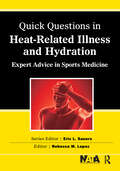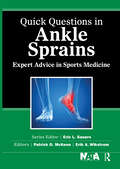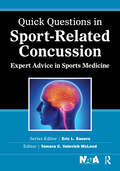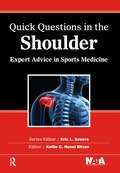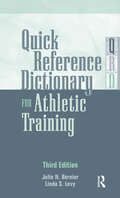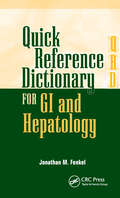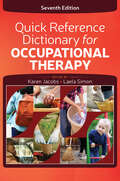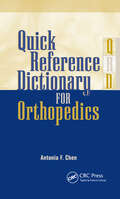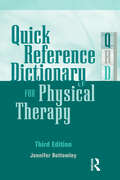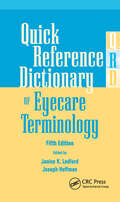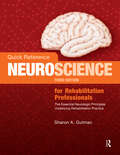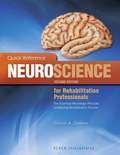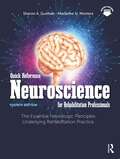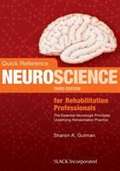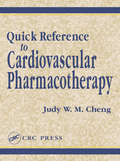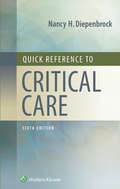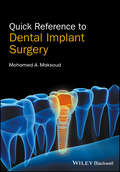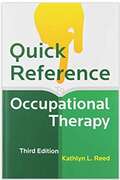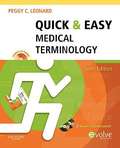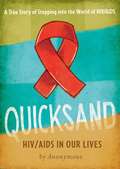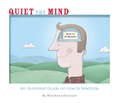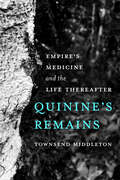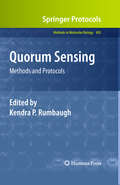- Table View
- List View
Quick Questions Heat-Related Illness: Expert Advice in Sports Medicine (Quick Questions in Sports Medicine)
by Rebecca LopezAre you looking for concise, practical answers to questions that are often left unanswered by traditional sports medicine references? Are you seeking brief, up-to-date, expert advice for common issues that can be encountered when working with athletes?Quick Questions in Heat-Related Illness and Hydration: Expert Advice in Sports Medicine provides a unique format of concise and to-the-point responses with clinical application, backed by the latest research on heat-related illnesses and hydration issues common among athletes. Dr. Rebecca M. Lopez and her contributors present 39 common clinical questions regarding topics such as how much and what kinds of fluids are optimal for performance and preventing illness, how to calculate an individual’s sweat rate, and the effect of supplements on hydration. Co-published with the National Athletic Trainers’ Association, Quick Questions in Heat Related Illness and Hydration: Expert Advice in Sports Medicine provides concise answers to 39 frequently asked clinical questions. Written in a conversational tone, the authors of the individual questions represent a variety of different backgrounds and are experts in their respective field. The variety of questions and brevity of responses will make this a book that is easy to read and reference at the point of care.Some sample sections and questions include: PreventionIs it possible to prevent death from exertional heat stroke? DiagnosisWhat temperature devices are valid when measuring internal body temperature in an exercising individual? Emergency managementDoes cold-water immersion cause shock or other adverse events? Environmental conditionsWhat are the best methods of assessing environmental conditions and what modifications should be made to work to rest ratios, practices and games based on the environment? Return to playWhat is the proper functional progression for an athlete returning to play following exertional heat stroke? HydrationWhat are the most practical, valid methods of measuring hydration status in athletes? Quick Questions in Heat-Related Illness and Hydration: Expert Advice in Sports Medicine is the perfect at-your-side resource for the athletic trainer, team physician, or sports medicine clinician looking for practical answers to heat-related illness and hydration questions. The concise and conversational tone allows the reader to readily apply the information into their everyday practice.
Quick Questions in Ankle Sprains: Expert Advice in Sports Medicine (Quick Questions in Sports Medicine)
by Patrick McKeon Erik WikstromAre you looking for concise, practical answers to questions that are often left unanswered by traditional sports medicine references? Are you seeking brief, up-to-date, expert advice for common issues that can be encountered when working with athletes?Quick Questions in Ankle Sprains: Expert Advice in Sports Medicine provides a unique format of concise and to the point responses with clinical application, backed by the latest research on sports-related ankle sprains among athletes. Drs. Patrick O. McKeon and Erik A. Wikstrom and their contributors present 39 common clinical questions regarding the prevention, assessment, treatment, management, and rehabilitation of ankle sprains. Co-published with the National Athletic Trainers’ Association, Quick Questions in Ankle Sprains: Expert Advice in Sports Medicine provides concise answers to 39 frequently asked clinical questions. Written in a conversational tone, the authors of the individual questions represent a variety of different backgrounds and are experts in their respective field. The variety of questions and brevity of responses will make this a book that is easy to read and reference at the point of care.Some sample sections and questions include: Risk and reduction of ankle sprainsWhat effect does prophylactic bracing and/or taping have on reducing lateral ankle sprain risk? DiagnosisWhat are the most useful clinical tests to accurately diagnose syndesmotic and medial ankle sprains? Treatment and rehabilitationTo what extent should I use manual therapies to treat ankle sprains and chronic ankle instability? Surgical considerationsWhen should I refer my patient with an ankle problem to an orthopedic surgeon? Quick Questions in Ankle Sprains: Expert Advice in Sports Medicine is the perfect at-your-side resource for the athletic trainer, team physician, or sports medicine clinician looking for practical answers to sports-related ankle sprain questions. The concise and conversational tone allows the reader to readily apply the information into their everyday practice.Other books in the Series Include: Quick Questions in Heat-Related Illness and Hydration Quick Questions in Sports-Related Concussion Quick Questions in the Shoulder
Quick Questions in Sport-Related Concussion: Expert Advice in Sports Medicine (Quick Questions in Sports Medicine)
by Tamara McLeodAre you looking for concise, practical answers to questions that are often left unanswered by traditional sports medicine references? Are you seeking brief, up-to-date, expert advice for common issues that can be encountered when working with athletes?Quick Questions in Sport-Related Concussion: Expert Advice in Sports Medicine provides a unique format of concise and to the point responses with clinical application, backed by the latest research on sport-related concussions among athletes. Dr. Tamara C. Valovich McLeod and her contributors present 39 common clinical questions and answers based on the author’s experience and the many different guidelines, consensus, and position statements that have garnered increased attention in the media and literature. Co-published with the National Athletic Trainers’ Association, Quick Questions in Sport-Related Concussion: Expert Advice in Sports Medicine provides concise answers to 39 frequently asked clinical questions. Written in a conversational tone, the authors of the individual questions represent a variety of different backgrounds and are experts in their respective field. The variety of questions and brevity of responses will make this a book that is easy to read and reference at the point of care.Some sample sections and questions include: Concussion BasicsWhat are the best educational materials available to help a coach, parent, or athlete learn about concussions? Pre-Season PlanningWhat are the most important regulations and policies to consider regarding the management of sport-related concussion? Concussion assessmentHow common are vestibular deficits following sport-related concussion and what tools are best used to assess vestibular function? Concussion management considerationAre there any rehabilitation exercises you can do to help a concussed athlete heal faster? Return to activityWhat is the role of the graded exertion protocols for making RTP decisions? Return to schoolWhat is cognitive rest and can it help recovery following concussion? Quick Questions in Sport-Related Concussion: Expert Advice in Sports Medicine is the perfect at-your-side resource for the athletic trainer, team physician, or sports medicine clinician looking for practical answers to sport-related concussion questions. The concise and conversational tone allows the reader to readily apply the information into their everyday practice.
Quick Questions in the Shoulder: Expert Advice in Sports Medicine (Quick Questions in Sports Medicine)
by Kelly BlivenAre you looking for concise, practical answers to questions that are often left unanswered by traditional sports medicine references? Are you seeking brief, up-to-date, expert advice for common issues that can be encountered when working with athletes?Quick Questions in the Shoulder: Expert Advice in Sports Medicine provides a unique format of concise and to the point responses with clinical application, backed by the latest research on shoulder injuries among athletes. Dr. Kellie C. Huxel Bliven and her contributors present 39 common clinical questions regarding the prevention, assessment, treatment, management, and rehabilitation of the shoulder. Co-published with the National Athletic Trainers’ Association, Quick Questions in the Shoulder: Expert Advice in Sports Medicine provides concise answers to 39 frequently asked clinical questions. Written in a conversational tone, the authors of the individual questions represent a variety of different backgrounds and are experts in their respective field. The variety of questions and brevity of responses will make this a book that is easy to read and reference at the point of care.Some sample sections and questions include: Factors related to shoulder functionHow does the trunk contribute to upper extremity function and injury risk in overhead athletes? Injury diagnosisWhat are the best clinical tests for determining if a patient has scapular dyskinesis and to determine if it is contributing to their shoulder pain and dysfunction? Injury treatment and rehabilitationWhat are the most effective glenohumeral mobilization techniques and when are they most appropriate to use to improve shoulder function and range of motion? The overhead athleteWhat assessments should be used in screening overhead athletes to determine who is at increased risk for injury and what are the most effective injury prevention strategies? Quick Questions in the Shoulder: Expert Advice in Sports Medicine is the perfect at-your-side resource for the athletic trainer, team physician, or sports medicine clinician looking for practical answers to sports-related shoulder injury questions. The concise and conversational tone allows the reader to readily apply the information into their everyday practice.
Quick Reference Dictionary for Athletic Training
by Linda Levy Julie N. BernierFor more than 10 years, the Quick Reference Dictionary for Athletic Training has assisted clinicians and students in applying current concepts applicable to the profession while in the classroom, clinic, or on the field.Now updated into a Third Edition, this pocket-sized, comprehensive, and user-friendly companion guide is an essential resource from Dr. Julie N. Bernier and Dr. Linda S. Levy.With over 2100 terms and 20 appendices, the Quick Reference Dictionary for Athletic Training, Third Edition includes a more complete series of neurologic and musculoskeletal special tests, as well as available evidence-based data including likelihood ratios, and interrater and intrarater reliability data to support the use of each test.Additional updates include:• References to accreditation• Goniometric range of motion measures• Pharmacology• Concussion assessment protocol• The NATA’s Code of EthicsThe Quick Reference Dictionary for Athletic Training, Third Edition will textually and visually provide the athletic training clinician and student with a quick overview of the essential elements of the profession.
Quick Reference Dictionary for GI and Hepatology
by Jonathan FenkelQuick Reference Dictionary for GI and Hepatology is a unique, pocket-sized reference designed specifically to provide a magnitude of terms and their definitions, guidelines, and references essential to the gastroenterology profession.Led by Dr. Jonathan Fenkel and his contributors, this compact, concise, and informative reference contains over 1000 commonly used GI and hepatology terms and definitions. Additionally, Quick Reference Dictionary for GI and Hepatology offers more than 20 quick reference appendices related to common GI and liver diseases. Some appendices include:• Causes of acute liver failure• Approach to elevated liver enzyme tests • Peptic ulcer disease: therapy and re-bleeding rates • Colorectal cancer surveillance guidelines• Scoring of acute pancreatitis• Types of gallstonesQuick Reference Dictionary for GI and Hepatology provides an at-your-fingertips guide for anyone who works in the gastroenterology profession, including gastroenterologists, medical students, residents, fellows, nurse practitioners, physician assistants, office staff, and industry sales representatives.
Quick Reference Dictionary for Occupational Therapy
by Karen Jacobs Laela SimonA leading resource for occupational therapy practitioners and students for 20 years, now updated with the latest information in the profession, Quick Reference Dictionary for Occupational Therapy, Seventh Edition is a resource for daily practice and academic training. Quick Reference Dictionary for Occupational Therapy, Seventh Edition by Dr. Karen Jacobs and Laela Simon remains the only comprehensive dictionary available specifically for occupational therapy. Containing more than 4,000 words and definitions, more than 60 appendices, and illustrations, graphs, and tables throughout, this definitive text has been updated with the latest information in current occupational therapy practice. New appendices in the Seventh Edition include: Commonly Used Assessments Emerging Practice Areas Expand Your Knowledge Grading Versus Adapting a Task Hand Pathologies State Regulatory Entities Theories and Frames of Reference Useful Apps A handy, conveniently sized reference in an easy-to-use format, Quick Reference Dictionary for Occupational Therapy, Seventh Edition gives occupational therapists, occupational therapy assistants, faculty, and students the most pertinent information they need day to day, right at their fingertips.
Quick Reference Dictionary for Orthopedics
by Antonia ChenThe Quick Reference Dictionary for Orthopedics by Dr. Antonia Chen is a portable, all-in-one, orthopedic resource for anyone who works with orthopedic patients. This pocket-size book focuses on commonly used orthopedic terms and definitions, with over 2,200 defined words — including anatomic terms and medical root terminology.Quick Reference Dictionary for Orthopedics also includes 25 in-depth appendices on a variety of orthopedic related topics such as imaging modalities, medication references for analgesia, antibiotics, and anticoagulation. Additionally, orthopedic eponyms, acronyms, and abbreviations are defined and described in detail.The anatomy of muscles, bones, and nerves, and vessels are described in detail, as well as the aspiration and injection of common joints. Quick Reference Dictionary for Orthopedics also covers common fracture classifications along with the appropriate splinting, bracing, or casting technique.Quick Reference Dictionary for Orthopedics provides an important, at your fingertips guide for anyone who works with orthopedic patients, including orthopedic surgeons, residents, fellows, medical students, physical therapists, athletic trainers, occupational therapists, and nurse practitioners.
Quick Reference Dictionary for Physical Therapy
by Jennifer BottomleyQuick Reference Dictionary for Physical Therapy has been revised and updated into a Third Edition to include the latest information in the field of physical therapy. This reference book, designed specifically for the physical therapy and physical therapist assistant student and practitioner, provides a magnitude of terms, definitions, guidelines, and references essential to the field. This Third Edition provides quick access to over 3400 words and their definitions that are encountered on a day-to-day basis (400 more than the previous edition). There are also 41 appendices in this user-friendly, pocket-sized reference where you can find information such as lists of general acronyms and abbreviations for words commonly used in physical therapy/rehabilitation; commonly used acronyms for evaluative tests and measures; and definitions of impairment, disability, and handicap as established and accepted by the World Health Organization. What is new inside the Third Edition:• More than 100 new abbreviations and acronyms• Updated Code of Ethics for the Physical Therapist• A new Drug Prescribing and Elimination Abbreviations appendix• Updates to suggested readingsQuick Reference Dictionary for Physical Therapy, Third Edition is the perfect, pocket size, affordable companion for school, clinical affiliations, and physical therapy practice.
Quick Reference Dictionary of Eyecare Terminology
by Janice K. Ledford Joseph HoffmanA leading resource for nearly two decades and a daily reference for thousands of eyecare professionals, the Fifth Edition of Quick Reference Dictionary of Eyecare Terminology continues this tradition and provides the latest terms, concepts, conditions, and important resources in an instant. Janice K. Ledford and Joseph Hoffman have updated and expanded this essential resource to reflect today’s dialect while retaining the core features associated with this user-friendly reference book: accurately defined terms, cross-referencing, acronyms and abbreviations, and a plethora of additional information in the appendices. Compact, concise, and informative, Quick Reference Dictionary of Eyecare Terminology, Fifth Edition, provides quick access to over 3,700 terms and their definitions, including over 400 new words. This pocket-sized companion also contains 25 appendices. Additionally, pronunciations have been added—an attribute users are sure to appreciate. With a history of excellence, an easy-to-use format, and the latest information, Quick Reference Dictionary of Eyecare Terminology, Fifth Edition is a must have for anyone working in eyecare or an eyecare-related industry.Features: An atlas of ocular anatomy drawings Updated list of pertinent web sites Updated drug tables A reading guide Appendices Include: Medical terminology Subjective grading systems Common abbreviations The metric system English-to-Spanish ocular history flow sheet
Quick Reference NeuroScience for Rehabilitation Professionals: The Essential Neurologic Principles Underlying Rehabilitation Practice
by Sharon A. Gutman"Quick Reference NeuroScience for Rehabilitation Professionals: The Essential Neurologic Principles Underlying Rehabilitation Practice, Third Edition" is a user-friendly, comprehensive text that specifically addresses the key information needed to understand the neuroscience of clinical rehabilitation. A concise and quick reference for the practitioner and student who are learning or reviewing the most relevant neuroscience principles supporting rehabilitation therapy. The updated third edition continues to meet a need in the rehabilitation profession that has gone unfilled - the ability to break down neuroscience information into the essential principles that can be used to understand neurological conditions and the principles underlying rehabilitation evaluation and practice. This fully-updated third edition provides a quick review of specific neuroscience concepts and principles that support rehabilitation interventions.In this era of information overload, this text rapidly and thoroughly provides condensed information in a user-friendly, easy-to-use format for readers to review and convey relevant information to patients. Sharon Gutman has organised the text into three parts: the first addresses neuroanatomy; the second addresses the function of neurological systems underlying physical, psychiatric, cognitive, and visual perceptual disorders; and the final section addresses clinical neuropathology related to ageing, addiction, memory, and the neurological substrates of sex and gender. A specific section describes the common neurodiagnostic tests that therapists do not administer but must have knowledge of when results are discussed at treatment team meetings.Features of the third edition: Presented in a simple and organised bulleted format. Large-scale colour illustrations to easily visualise neuroanatomical structures and systems. Text boxes to apply key neuroscience concepts to the understanding of common neurological disorders and treatment. Updated clinical test questions and glossary. The third edition bridges a gap by quickly providing the rehabilitation professional with the most salient information needed to understand neurologic principles underlying rehabilitation practice.
Quick Reference Neuroscience For Rehabilitation Professionals: The Essential Neurologic Principles Underlying Rehabilitation Practice
by Sharon GutmanQuick Reference NeuroScience for Rehabilitation Professionals: The Essential Neurologic Principles Underlying Rehabilitation Practice, Second Edition is a user-friendly, comprehensive text that specifically addresses the key information needed to understand the neuroscience of clinical rehabilitation. This updated Second Edition is designed to provide complex information in a quick, easy-to-use format that is beneficial to students and rehabilitation professionals. Dr. Sharon A. Gutman designed Quick Reference NeuroScience for Rehabilitation Professionals, Second Edition to provide easy-to-understand explanations of complex neurologic phenomena. The text describes basic neuroanatomical structures and functions, neuropathology underlying specific clinical conditions, and theories supporting clinical treatment. Features of the Second Edition: • User-friendly, bulleted outline format • Italicized key concepts for easy scanning and identification • Color illustrations to help visualize the location of neuroanatomical structures • New clinical test questions • New text boxes outlining neurologic conditions and treatments • Updated and expanded glossary with both clinical and neurological terms Including accessible information, color illustrations, new test questions, and updated features, Quick Reference NeuroScience for Rehabilitation Professionals: The Essential Neurologic Principles Underlying Rehabilitation Practice, Second Edition is a dynamic text for all students and clinicians in occupational therapy, physical therapy, and other areas of rehabilitation.
Quick Reference Neuroscience for Rehabilitation Professionals: The Essential Neurologic Principles Underlying Rehabilitation Practice
by Sharon A. Gutman Marianne H. MorteraThe fourth edition of this concise and accessible book continues to provide readers with the fundamentals of clinical neuroscience, the essentials of neurological functioning, and the neurological basis for a range of rehabilitation practices.The book starts by illustrating the basics of neuroanatomy, before addressing the function of neurological systems underlying motor, sensory, visual, perceptual, cognitive, emotional, and memory disorders. Along with new full color illustrations and photographs, the book has been updated to include the following additional material: Full screening procedures have been added to the cranial nerve section. Full color illustrations have been added to the special sense receptor section to illustrate the clinical pathology underlying visual field impairments. New sections have been added addressing attention and cognition. A subsection, "Occupational Performance Implications," was added to all sections to help readers understand how function/dysfunction of neuroanatomical systems impact performance in daily life activities. This updated fourth edition continues to be essential reading for any healthcare professional working in rehabilitation, or students on the journey to become rehabilitation professionals.
Quick Reference Neuroscience for Rehabilitation Professionals: The Essential Neurologic Principles Underlying Rehabilitation Practice
by Sharon A. GutmanA concise and quick reference for the practitioner and student who are learning or reviewing the most relevant neuroscience principles supporting rehabilitation therapy. The updated third edition continues to meet a need in the rehabilitation profession that has gone unfilled - the ability to break down neuroscience information into the essential principles that can be used to understand neurological conditions and the principles underlying rehabilitation evaluation and practice. This fully-updated third edition provides a quick review of specific neuroscience concepts and principles that support rehabilitation interventions. In this era of information overload, this text rapidly and thoroughly provides condensed information in a user-friendly, easy-to-use format for readers to review and convey relevant information to patients. Sharon Gutman has organised the text into three parts: the first addresses neuroanatomy; the second addresses the function of neurological systems underlying physical, psychiatric, cognitive, and visual perceptual disorders; and the final section addresses clinical neuropathology related to ageing, addiction, memory, and the neurological substrates of sex and gender. A specific section describes the common neurodiagnostic tests that therapists do not administer but must have knowledge of when results are discussed at treatment team meetings. Features of the third edition: Presented in a simple and organised bulleted format. Large-scale colour illustrations to easily visualise neuroanatomical structures and systems. Text boxes to apply key neuroscience concepts to the understanding of common neurological disorders and treatment. Updated clinical test questions and glossary. The third edition bridges a gap by quickly providing the rehabilitation professional with the most salient information needed to understand neurologic principles underlying rehabilitation practice.
Quick Reference to Cardiovascular Pharmacotherapy (Pharmacy Education Series)
by Judy W. M. ChengCardiovascular disease is the leading cause of death in the United States and is the focus of ongoing research. Consequently, treatment of cardiovascular disorders is among the most highly evidence-based area of medicine and pharmacy practice.Quick Reference to Cardiovascular Pharmacotherapy provides important guidelines and standards of ca
Quick Reference to Critical Care
by Nancy H. DiepenbrockThis indispensable pocket guide addresses a broad range of critical care patient topics, divided by body system and organized alphabetically within each chapter for quick access. Disease processes, disorders, medications, and titration, tests, lab results, formulas, ICU equipment and treatment strategies and goals are discussed. Each well-illustrated entry explains the latest evidence-based procedures and stabilization practices in a convenient, quick-read outline, making it the ideal quick reference for following proven protocols.
Quick Reference to Dental Implant Surgery
by Mohamed A. MaksoudQuick Reference to Dental Implant Surgery offers busy practitioners quick access to all the essential information needed for successful dental implant surgery—from case selection to radiographic examination, scrub-in to post-operative care. How-to information in a concise, spiral-bound, quick-access format Concrete guidelines for common scenarios before, during, and after surgery Numerous charts, tables, checklists, and callouts An abundance of stunning, full-color photographs illustrating key points covered Text boxes containing clinical recommendations to help facilitate quick navigation
Quick Reference to Occupational Therapy
by Kathlyn L. ReedThis greatly enhanced and expanded Third Edition of Quick Reference to Occupational Therapy adds sixty-five topics and disorders to the already extensive list. All information in the text is updated. New and veteran therapists will benefit from having the latest disorder-specific information at their fingertips as they assess and treat clients. An extensive References for Further Reading section includes a review of the levels of evidence for each journal article. <p><p>Contents include: Developmental Disorders Sensory Disorders, Nervous System Disorders, Cardiopulmonary Disorders, Hand and Wrist Conditions, Injuries, Musculoskeletal Disorders, Systemic Disorders, Immunologic and Infectious Diseases, Skin Disorders, Cognitive-Perceptual Disorders, and Mental Disorders Lifestyle Disorders,
Quick and Easy Medical Terminology (6th Edition)
by Peggy C. LeonardMake learning medical terminology faster and more fun with Quick & Easy Medical Terminology, 6th Edition! Featuring CDs with interactive games and audio pronunciations, this book helps you begin reading, writing, and speaking medical terms in the shortest time possible. Small chunks of information are always followed immediately by exercises, so students will be learning "every minute!" The many puzzles, activities, and games make it easier to understand and remember terminology. Written in a clear, conversational style by Peggy C. Leonard, MT, MEd, this book gives you the tools to communicate effectively in the health care environment. A companion CD reinforces learning with fun, interactive exercises, including medical reports and Hear It/Spell It exercises. Two audio CDs let you listen to correct pronunciations of medical terms and encourage you to pronounce each term aloud. A flexible, body systems organization lets you go through the material in any order after completing the orientation chapters, making it easy to coordinate your study with other courses such as anatomy and physiology. The programmed learning approach presents content in small blocks called 'frames' that allow you to learn the content and get immediate feedback on your progress before proceeding. Diverse learning styles are accommodated by a wide variety of exercises -- labeling diagrams, writing terms, choosing pronunciation accents, recognizing misspelled terms, matching word parts, interpreting terms within health reports, and categorizing terms. Unique! A conversational writing style makes the book more readable and enjoyable. Unique! Thorough explanations of terms help you understand and remember the material by presenting terminology in a medical context. A consistent format to body systems chapters uses categories to simplify the learning of terms, with each chapter including function; structure; diseases, disorders, and diagnostic terms; and surgical and therapeutic interventions. Healthcare reports and case studies allow you to apply your knowledge to real-life situations. A review of anatomy and physiology at the beginning of each body systems chapter provides a context for understanding the medical terminology. Drug information is integrated into the body systems chapters, with detailed information on specific drugs on CD. Caution boxes alert you to confusing terms. Spanish translations of key terms are listed in each chapter to help you communicate with Hispanic patients; glossaries are included in the appendix. Comprehensive end-of-chapter reviews correspond to the learning objectives at the beginning of the chapter. A bookmark includes a quick-reference guide to pronouncing terms plus a list of pronunciation symbols. A companion Evolve website includes study tips, electronic flashcards, Body Spectrum coloring pages, an English/Spanish glossary, learning activities that include Spanish term exercises, updates, and links to related sites. More short exercises include Find the Clue and Connections puzzles, letting you check your learning more often and stay on track. Procedures and terminology updates keep you current with new technologies and terms you'll encounter in the workplace. Quick Tips in the margins add essential information and interesting, fun facts. Games add fun and competition to exercises on the companion CD. More medical reports with exercises are included on the CD, allowing you to use terms in real-life situations.
Quicksand: HIV/AIDS in Our Lives
by Anonymous<P>What is it like to be affected by HIV/AIDS? <P>A moving first-person account offers insight- and basic facts. <P>One day I found out that someone I know- my brother-in-law, Jay- had HIV/AIDS. <P>At the moment I heard his diagnosis, I realized that I had stepped into the quicksand of a new and terrible world -- and I was sinking fast. <P>Weaving together her own story with straightforward questions and answers, the author explains the real ways that HIV/AIDS can be transmitted and explores the common experiences and emotions that might be encountered by friends and family members of someone who has the virus. <P>She also discusses why HIV/AIDS is often still kept a secret and the importance of treating this condition like any other. <P>With up-to-date medical information that has been thoroughly vetted by experts, this first-person narrative offers an invaluable look at what it is like to watch someone you know battle HIV/AIDS.
Quiet the Mind
by Matthew JohnstoneIn a world where finding even ten minutes to 'do nothing' can be difficult, the benefits of meditation can be profound. Meditation is simply a way of giving our brains a well-deserved break and can actually help our brains to function healthily and happily. This beautifully illustrated guide is an inspiring and practical book which shows you how to meditate without the need for uncomfortable lotus positions or prayer beads! With his typical gentle and insightful humour, Matthew's guide to meditation will enable to you to feel more present, more youthful, have more energy and greater concentration, improve your mood and sleep more soundly.
Quinine's Remains: Empire's Medicine and the Life Thereafter
by Townsend MiddletonA free ebook version of this title is available through Luminos, University of California Press's Open Access publishing program. Visit www.luminosoa.org to learn more. What happens after colonial industries have run their course—after the factory closes and the fields go fallow? Set in the cinchona plantations of India’s Darjeeling Hills, Quinine’s Remains chronicles the history and aftermaths of quinine. Harvested from cinchona bark, quinine was malaria’s only remedy until the twentieth-century advent of synthetic drugs, and it was vital to the British Empire. Today, the cinchona plantations—and the roughly fifty thousand people who call them home—remain. Their futures, however, are unclear. The Indian government has threatened to privatize or shut down this seemingly obsolete and crumbling industry, but the plantation community, led by strident trade unions, has successfully resisted. Overgrown cinchona fields and shuttered quinine factories may appear the stuff of postcolonial and postindustrial ruination, but quinine’s remains are not dead. Rather, they have become the site of urgent efforts to redefine land and life for the twenty-first century. Quinine's Remains offers a vivid historical and ethnographic portrait of what it means to forge life after empire.
Quintessential Occupational Therapy: A Guide to Areas of Practice
by Robin AkselrudOffering a glimpse into the daily schedule, caseload, and roles of clinicians in more than 15 areas of practice, Quintessential Occupational Therapy: A Guide to Areas of Practice is an essential resource for recent graduates and occupational therapists looking to enter a new area of practice.Each chapter focuses on a different area of practice—from outpatient rehabilitation to home care—and is authored by a team of seasoned clinicians who offer advice, work samples, and tips for those entering that area of practice. Quintessential Occupational Therapy also features experts across states and settings to provide the reader with a holistic view and understanding of the practice area they seek to enter.What’s included in Quintessential Occupational Therapy: Sample forms and documents used in a variety of practice settings Common treatment plans and information on clinical diagnoses in each area of practice Guides for testing and relevant clinical information for each setting Quintessential Occupational Therapy: A Guide to Areas of Practice will equip readers with the knowledge and understanding of a variety of practice settings in occupational therapy and is perfect for recent graduates and practicing clinicians alike.
Quirks of Human Anatomy: An Evo-devo Look at the Human Body
by Lewis I. Held Jr.With the emergence of the new field of evolutionary developmental biology we are witnessing a renaissance of Darwin's insights 150 years after his Origin of Species. Thus far, the exciting findings from "evo-devo" have only been trickling into college courses and into the domain of non-specialists. With its focus on the human organism, Quirks of Human Anatomy opens the floodgates by stating the arguments of evo-devo in plain English, and by offering a cornucopia of interesting case studies and examples. Its didactic value is enhanced by 24 schematic diagrams that integrate a host of disparate observations, by its Socratic question-and-answer format, and by its unprecedented compilation of the literature. By framing the "hows" of development in terms of the "whys" of evolution, it lets readers probe the deepest questions of biology. Readers will find the book not only educational but also enjoyable, as it revels in the fun of scientific exploration.
Quorum Sensing
by Kendra P. RumbaughSince its early days in the 1990s, the Quorum Sensing (QS) field has grown from a few dozen laboratories, investigating the pathways, proteins, and chemicals that facilitate signaling in bacteria, to hundreds of groups that have integrated evolutionary biology, computer science, mathematics, engineering, and metagenomics to create an ever-expanding and dynamic field. In Quorum Sensing: Methods and Protocols, expert researchers provide an in-depth set of diverse protocols that span this broad area of study. Broken into three detailed sections, the volume covers the detection, isolation, and characterization of the QS signals made by both Gram- and Gram+ bacteria, determination of the function of QS signals in vivo, and the development of QS disruption strategies. Written in the highly successful Methods in Molecular BiologyTM series format, chapters include brief introductions to their respective topics, lists of the necessary materials and reagents, step-by-step, readily reproducible laboratory protocols, and expert tips on troubleshooting and avoiding known experimental pitfalls. Comprehensive and cutting-edge, Quorum Sensing: Methods and Protocols serves as an invaluable collection of easily accessible techniques for scientists seeking to further our knowledge about bacterial communication and its relation to humanity.
